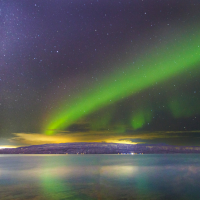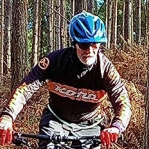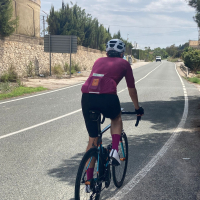La Vuelta 2020 - Stage 12: Pola de Laviana > Alto de l'Angliru - 109,4 km *Spoilers*

The 12th stage of the Vuelta a España, at 109.4 kilometres, the route takes in four intermediate climbs to finish uphill atop the iconic Angliru. The 12.4 kilometres ascent slopes at 9.9%.

So it is a relatively short race and since the first 26 kilometres are flat the climbing becomes even more condensed. These intermediate climbs get harder as the race heads towards the Alto El Angliru.

The first two climbs are perfect to stretch the legs. The Alto del Padrún and Alto de San Emiliano are both relatively easy. The first one is 3 kilometres long and slopes at 6.6%
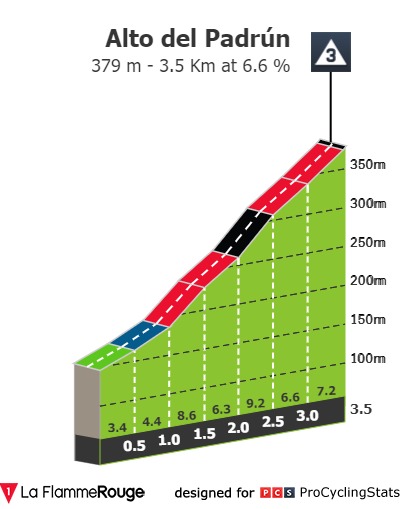
while the second is a 5.8 kilometres climb with an average gradient of 5.9%.
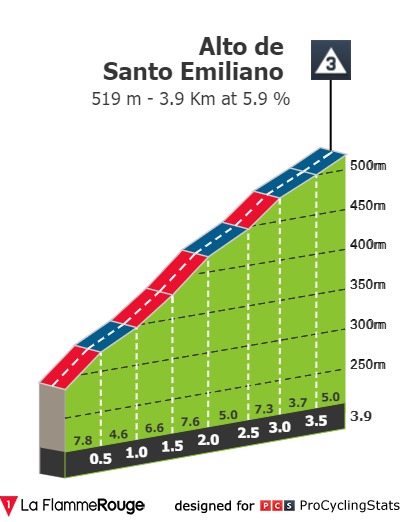
The riders are halfway when the Alto de Mozqueta appears, which is an ascent of 6.6 kilometres at 8.4% with an extra steep first part.

Following a long downhill and a section through the valley the Alto de Cordal serves as a kind of prelude to the Angliru. The 5.4 kilometres climb is extremely irregular with several sections exceeding 13%, while the average gradient sits at 9.3%.

La Vuelta last visited the Alto de El Angliru climb in 2017, which was to be the last mountain stage of Alberto Contador's career. In fact it was the penultimate race of that edition. El Pistolero had been on the attack for three weeks without winning.
He climbed to victory ahead of Wout Poels and Chris Froome, who won the Spanish Grand Tour for the first time in his career.

The Angliru is 12.4 kilometres long. The first 5 kilometres go up at 8% and following a relatively flat kilometre the uphill horror really kicks in. The second half of the climb is at an average gradient of 15%. Riders face the steepest sector of 23.5% – aptly named Cueña les Cabres (goat path) – with 3 kilometres remaining.

La Pola Llaviana/Pola de Laviana
Unprecedented departure
13.087 inhabitants
Pola de Laviana is known in the Principality of Asturias for hosting one of the area’s most popular festivities: the Folkloric Descent of the Nalón. At this event, celebrated for over half a century, different local clubs build their own boats featuring various themed decorations. This fun-filled atmosphere is shared by the entire municipality and will serve as a warm-up for the arrival of the momentous Spanish cycling celebration just one week later.


Alto de l'Angliru
7 stages of La Vuelta have had finales in the Alto de l’Angliru
1.933 inhabitants
Angliru is one of the climbs that all cycling aficionados have to do. Along with the likes of Alpe d'Huez, Tourmalet and Mortirolo it has a mystique and reputation that stretches further than the mountain itself.
It's infamy is based on the numerous steep ramps that you encounter on the final six kilometres of the climb. However, the incredible, almost unique scenery, and the near complete lack of cars makes it one of the most challenging of ascents.
Angliru is nestled in between two of the most impressive mountain ranges in Spain. The Picos de Europa lie to the east, and the Somiedo Natural Park is to the south-west.

Cachopo.
Cachopo is a dish characteristic of Asturian cuisine. It consists of two large veal fillets and includes ham and cheese. The dish is eaten fried and hot after being breaded in eggs and breadcrumbs, and it is usually served garnished with potatoes, peppers, or mushrooms.

Pitu de caleya (free-range chicken) con arbeyinos patatas

Tarta Afuega' l Pitu

Comments
-
Just a little reminder of what they face tomorrow.
0 -
It was, it was called 'It's a Knockout', and the international version was 'Jeux sans Frontiers', but for some bizarre reason it got binned.RichN95. said:
Why is this not on TV?0 -
Dorset_Boy said:
It was, it was called 'It's a Knockout', but for some bizarre reason it got binned.RichN95. said:
Why is this not on TV?
That sections looks horrific from that angle.andyp said:Just a little reminder of what they face tomorrow.
0 -
Oh, I remember that. A childhood favourite. I've often referred to Cyclocross as the cycling version of it - "And here come the Belgians". But now they can never be shown again.Dorset_Boy said:
It was, it was called 'It's a Knockout', and the international version was 'Jeux sans Frontiers', but for some bizarre reason it got binned.Twitter: @RichN950 -
-
Stuart Hall's commentary was almost an essential part of it though. Mind you as adults we might have found it as annoying as Carlton C.0
-
Stuart Hall trying to cuddle Eddie Waring. They don’t make TV like that anymore.0
-
Ah. Yes. Stuart Hall of the groom the minors cadre. Twunt.0
-
Dorset_Boy said:
Stuart Hall's commentary was almost an essential part of it though. Mind you as adults we might have found it as annoying as Carlton C.
Say what you like about Carlton, but he's seems a genuinely decent guy and not a pervert. Duffield, Harmon, McCrossan, Kirby, Hatch, Quigley. Eurosport Cycling are so far batting 0.833 on their commentators.Twitter: @RichN950 -
Ha. 50% chance this post gets pulled. One of them is very into using lawyers when speaking to BRRichN95. said:Dorset_Boy said:Stuart Hall's commentary was almost an essential part of it though. Mind you as adults we might have found it as annoying as Carlton C.
Say what you like about Carlton, but he's seems a genuinely decent guy and not a pervert. Duffield, Harmon, McCrossan, Kirby, Hatch, Quigley. Eurosport Cycling are so far batting 0.833 on their commentators.0 -
Oh, I'm not justifying the crimes of the likes of Hall and the rest of the BBC of the time.RichN95. said:Dorset_Boy said:Stuart Hall's commentary was almost an essential part of it though. Mind you as adults we might have found it as annoying as Carlton C.
Say what you like about Carlton, but he's seems a genuinely decent guy and not a pervert. Duffield, Harmon, McCrossan, Kirby, Hatch, Quigley. Eurosport Cycling are so far batting 0.833 on their commentators.0 -
Carlton would be in his element if they remade It's A Knockout. Someone should do it to give him a suitable commentary home.0
-
-
I don't know about the "Folkloric Descent of the Nalón"....... I raced (kayak) on the River Nalón back in 1965 and it was a race out into the estuary, round an island then back up the Nalón. Bloody hard work going against the stream. The Spanish stitched up all the foreign teams by hanging back then carrying their kayaks across a narrow strip of land across a horsehoe bend thereby cutting off a considerable distance. That, and other first hand instances of Spanish sportsmanship have clouded my views ever since.blazing_saddles said:Stage 12: Pola de Laviana > Alto de l'Angliru - 109,4 km
Pola de Laviana is known in the Principality of Asturias for hosting one of the area’s most popular festivities: the Folkloric Descent of the Nalón. At this event, celebrated for over half a century, different local clubs build their own boats featuring various themed decorations. This fun-filled atmosphere is shared by the entire municipality and will serve as a warm-up for the arrival of the momentous Spanish cycling celebration just one week later.


“You may think that; I couldn’t possibly comment!”
Wilier Cento Uno SR/Wilier Mortirolo/Specialized Roubaix Comp/Kona Hei Hei/Calibre Bossnut0 -
Warning No formatter is installed for the format0 -
Even though I know the Angliru is ridden for survival and doesn't bring out attacking racing, I still get excited about it.Warning No formatter is installed for the format0
-
I wonder how many different pronunciations of "Angliru" Sean will manage today...
Any idea what time they'll be hitting the final climb?0 -
Well, if you believe the official schedules, any time between 3-45 and 4-05pm.mrb123 said:I wonder how many different pronunciations of "Angliru" Sean will manage today...
Any idea what time they'll be hitting the final climb?
However, the official schedules have them completing the final 12.4kms in 20 minutes.
Good luck with that, lads!
I reckon around 3-30pm our time."Science is a tool for cheaters". An anonymous French PE teacher.0 -
No one is drafting up it to the sprint the last 300 metres.No_Ta_Doctor said:Even though I know the Angliru is ridden for survival and doesn't bring out attacking racing, I still get excited about it.
0 -
It would be a fast one though, as it's downhill.kingstongraham said:
No one is drafting up it to the sprint the last 300 metres.No_Ta_Doctor said:Even though I know the Angliru is ridden for survival and doesn't bring out attacking racing, I still get excited about it.
"Science is a tool for cheaters". An anonymous French PE teacher.0 -
That's one Sunday ride cut short ... What's happening?"If I was a 38 year old man, I definitely wouldn't be riding a bright yellow bike with Hello Kitty disc wheels, put it that way. What we're witnessing here is the world's most high profile mid-life crisis" Afx237vi Mon Jul 20, 2009 2:43 pm0
-
About 86km to the foot of the climb at the moment with a fast, slightly downhill start so at a guess they'll average over 30km/h which would get them to the base by somewhere between 3.15 and 3.30blazing_saddles said:
Well, if you believe the official schedules, any time between 3-45 and 4-05pm.mrb123 said:I wonder how many different pronunciations of "Angliru" Sean will manage today...
Any idea what time they'll be hitting the final climb?
However, the official schedules have them completing the final 12.4kms in 20 minutes.
Good luck with that, lads!
I reckon around 3-30pm our time.0 -
No break ?"If I was a 38 year old man, I definitely wouldn't be riding a bright yellow bike with Hello Kitty disc wheels, put it that way. What we're witnessing here is the world's most high profile mid-life crisis" Afx237vi Mon Jul 20, 2009 2:43 pm0
-
Ineos look keen to get a man in the break. This is a bad start for the non-climbers, very fast meaning that time cut is going to be shorter. Quite a big group has opened a gap of about 20".0
-
They can't decide whether to push on or not.0



